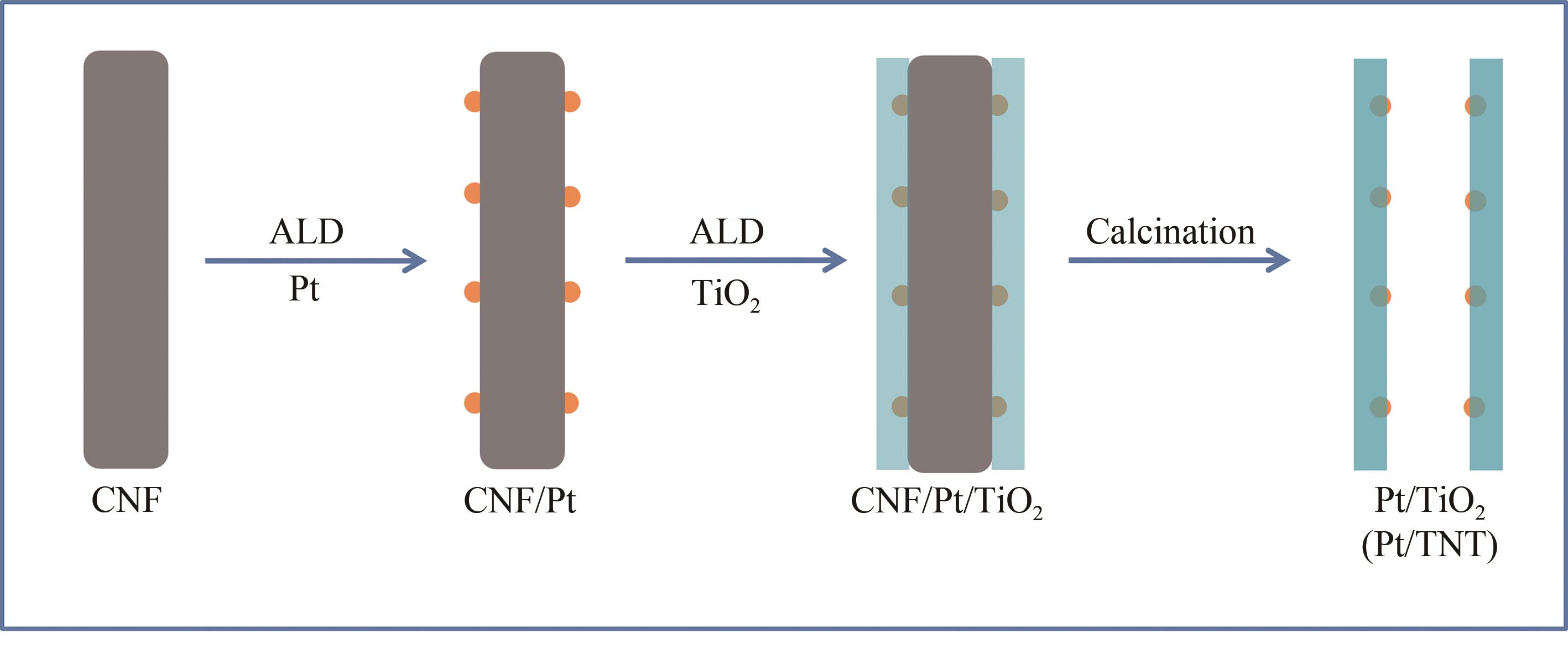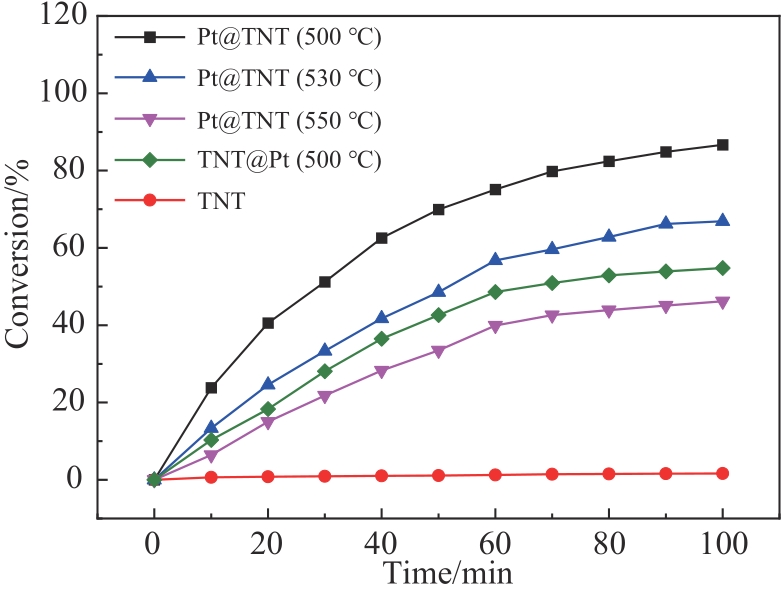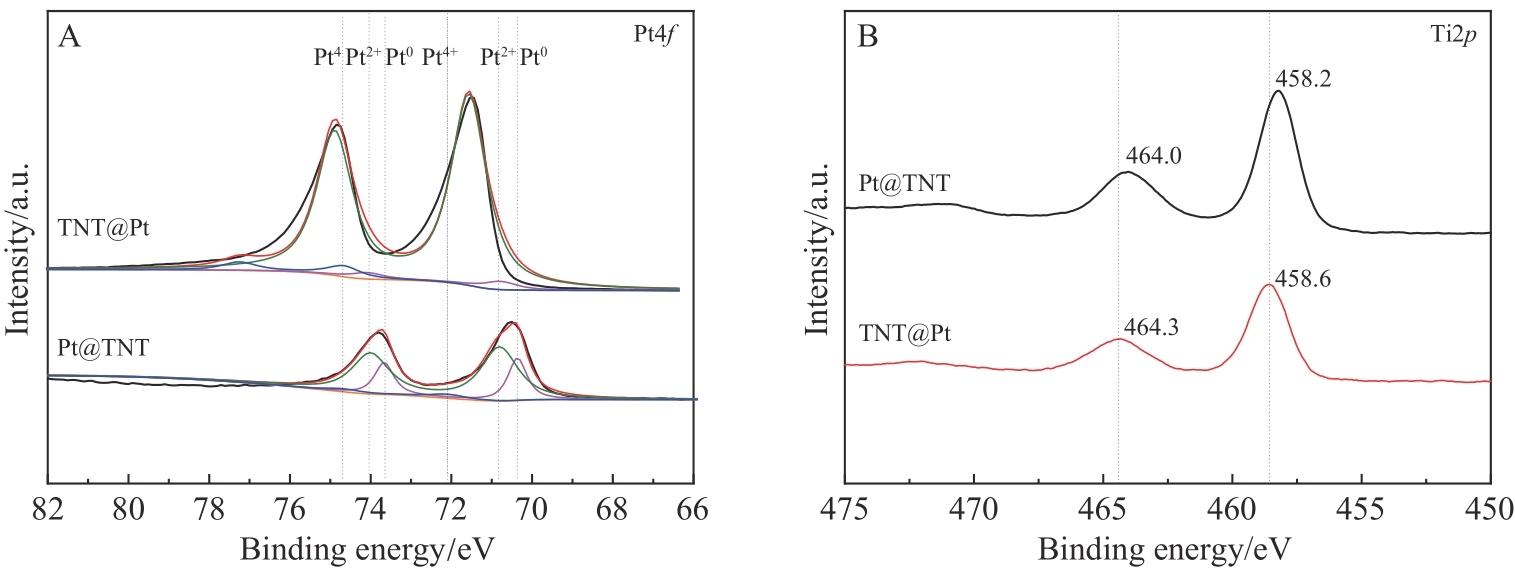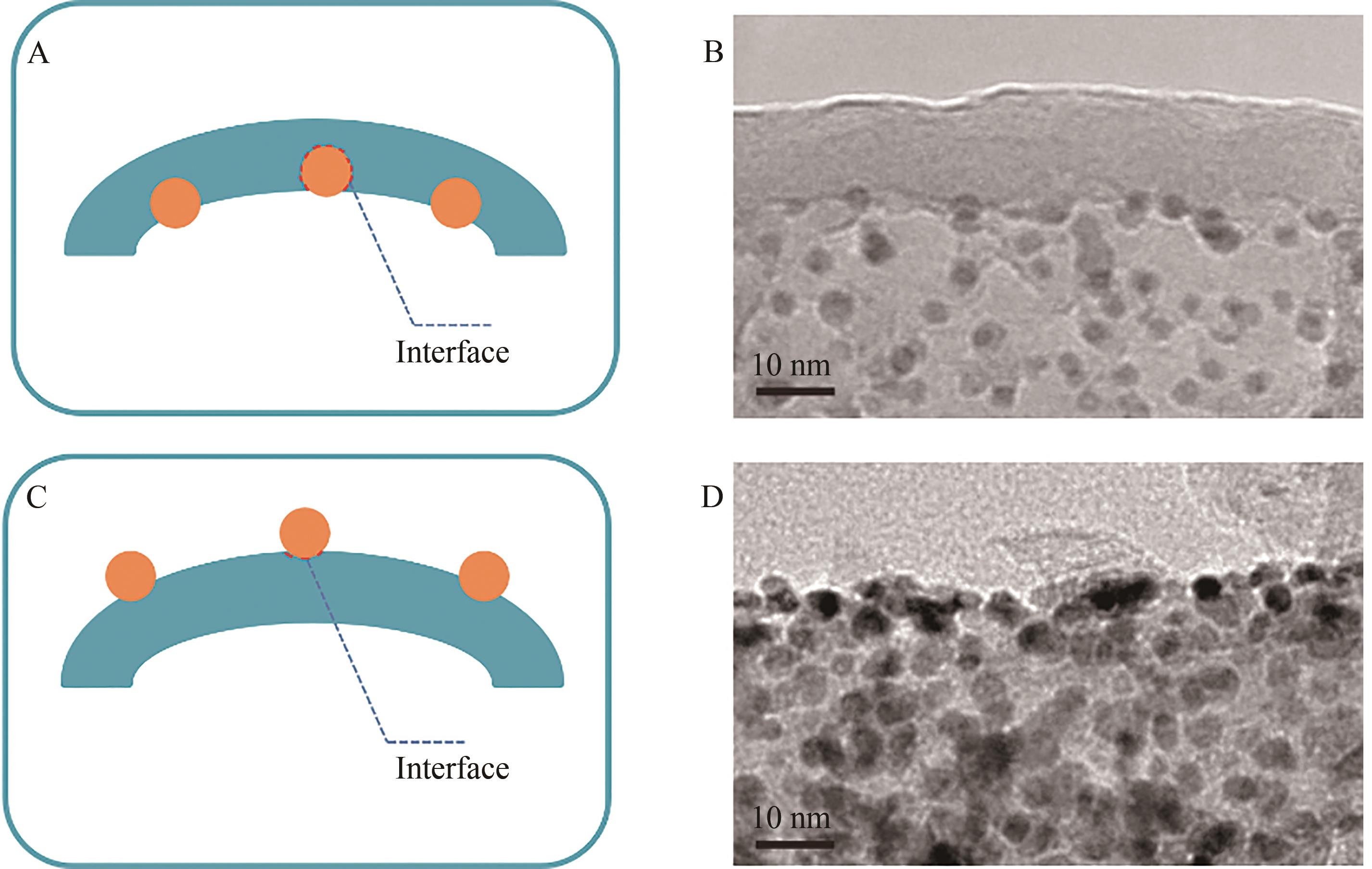
Chinese Journal of Applied Chemistry ›› 2024, Vol. 41 ›› Issue (4): 547-556.DOI: 10.19894/j.issn.1000-0518.230346
• Full Papers • Previous Articles Next Articles
Preparation and Catalytic Performance of the Confined Pt Catalyst by Atomic Layer Deposition
Mei-Hua WANG1, Yu FENG1, Yun-Kun WANG1, Xu-Dong ZHAO1, Wen YANG1( ), Chuan DONG2(
), Chuan DONG2( )
)
- 1.Instrumental Analysis Center,School of Material Science and Engineering,Taiyuan University of Science and Technology,Taiyuan 030024,China
2.Institute of Environmental Science,Shanxi University,Taiyuan 030006,China
-
Received:2023-11-06Accepted:2024-02-20Published:2024-04-01Online:2024-04-28 -
Contact:Wen YANG,Chuan DONG -
About author:dc@sxu.edu.cn
yangwen@tyust.edu.cn;
-
Supported by:Shanxi Province Science and Technology Innovation Talent Team Special Project(202204051001002);Shanxi Province Basic Research Program Funding Project(20210302124471);the National Natural Science Foundation of China(22208230);Shanxi Provincial Excellent Support Program for Returned Overseas Scholars(20230033)
CLC Number:
Cite this article
Mei-Hua WANG, Yu FENG, Yun-Kun WANG, Xu-Dong ZHAO, Wen YANG, Chuan DONG. Preparation and Catalytic Performance of the Confined Pt Catalyst by Atomic Layer Deposition[J]. Chinese Journal of Applied Chemistry, 2024, 41(4): 547-556.
share this article
Add to citation manager EndNote|Ris|BibTeX
URL: http://yyhx.ciac.jl.cn/EN/10.19894/j.issn.1000-0518.230346
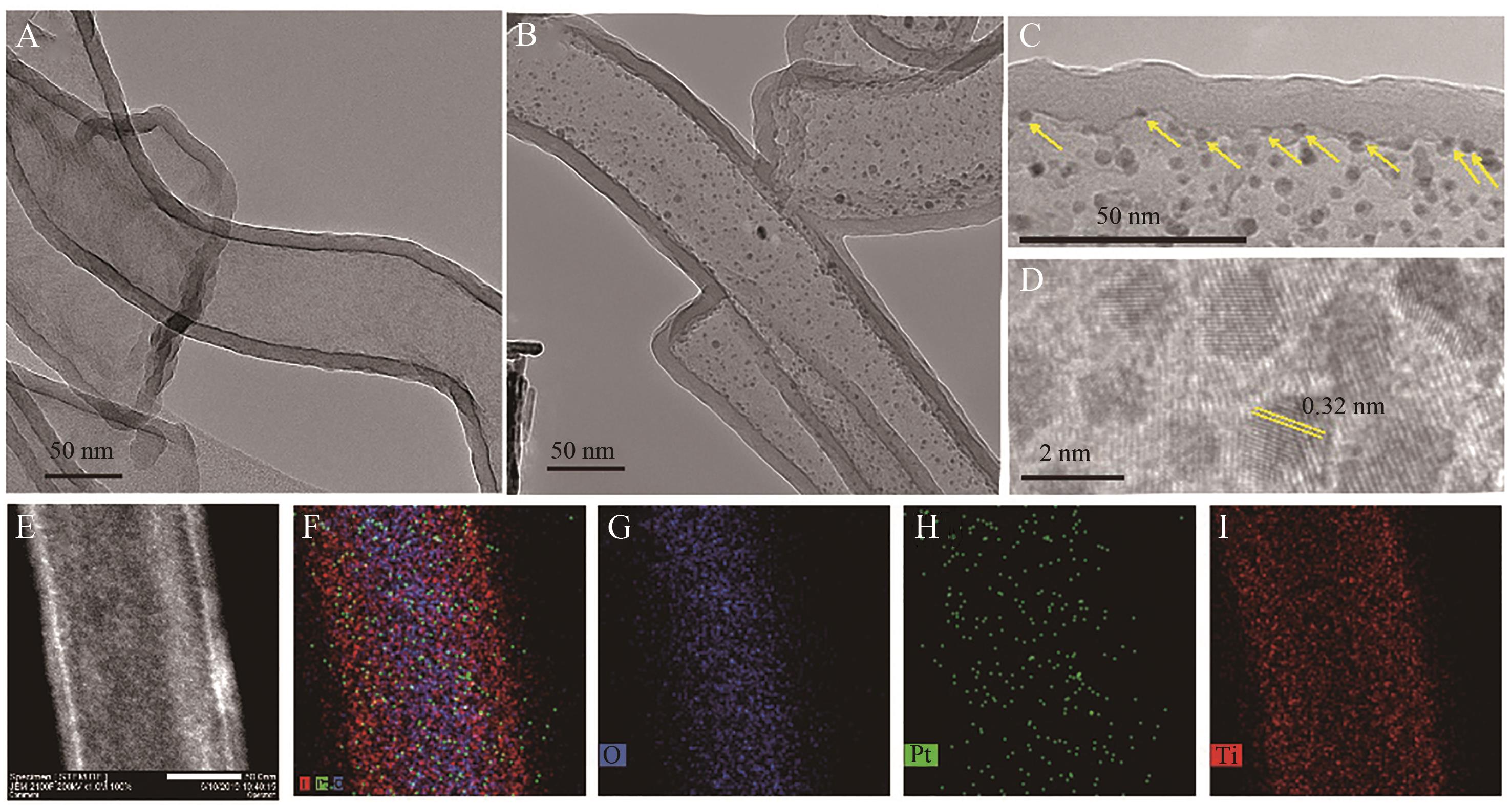
Fig.2 TEM images of (A) TiO2 nanotubes and (B) Pt nanoparticles in TiO2 nanotubes. High resolution transmission electron microscopy of Pt nanoparticles (C, D). The STEM (E) and Mapping element diagram of Pt nanoparticles in TiO2 nanotubes, representing O (G), Pt (H), Ti (I) and their overlap (F)
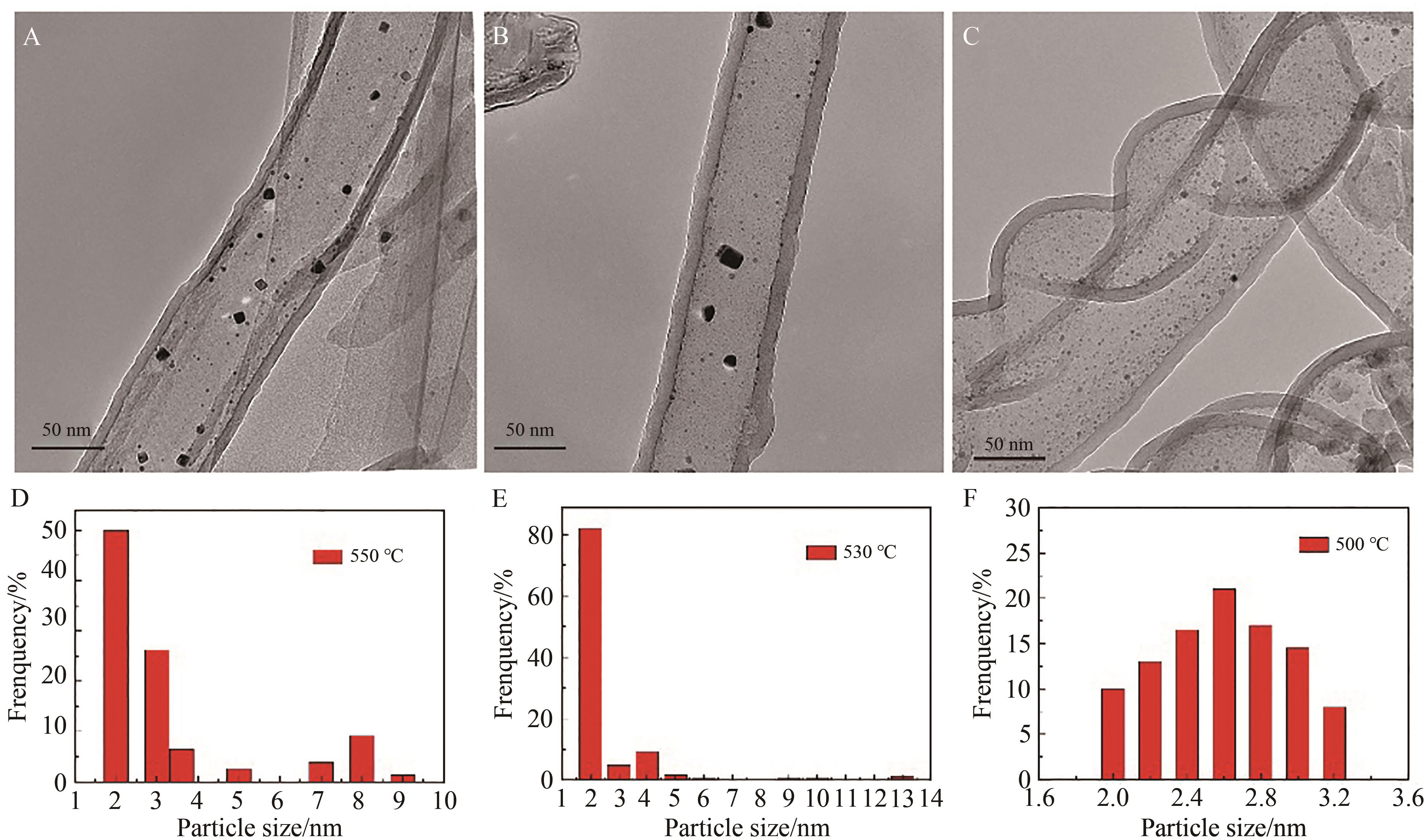
Fig.3 TEM images of Pt nanoparticles in TiO2 nanotubes sintered at (A) 550, (B) 530 and (C) 500 ℃ and size distribution of corresponding Pt nanoparticles (D, E, F)
| Sample | w( Pt)/% a | Conversion/% b | Selectivity/% c | TOF/h-1 d |
|---|---|---|---|---|
| TNT@Pt | 2.55 | 46.2 | 98.7 | 281.5 |
| Pt@TNT(500 ℃) | 2.44 | 75.1 | 97.0 | 482.1 |
Pt@TNT(530 ℃) Pt@TNT(550 ℃) Pt@TNT4th | 2.36 2.49 2.33 | 56.8 39.9 70.3 | 97.2 96.8 98.5 | 377.1 249.9 472.7 |
| TNT@Pt4th | 1.01 | 10.3 | 94.3 | 159.1 |
Table 1 Catalytic performance of these samples for the hydrogenation of phenol
| Sample | w( Pt)/% a | Conversion/% b | Selectivity/% c | TOF/h-1 d |
|---|---|---|---|---|
| TNT@Pt | 2.55 | 46.2 | 98.7 | 281.5 |
| Pt@TNT(500 ℃) | 2.44 | 75.1 | 97.0 | 482.1 |
Pt@TNT(530 ℃) Pt@TNT(550 ℃) Pt@TNT4th | 2.36 2.49 2.33 | 56.8 39.9 70.3 | 97.2 96.8 98.5 | 377.1 249.9 472.7 |
| TNT@Pt4th | 1.01 | 10.3 | 94.3 | 159.1 |
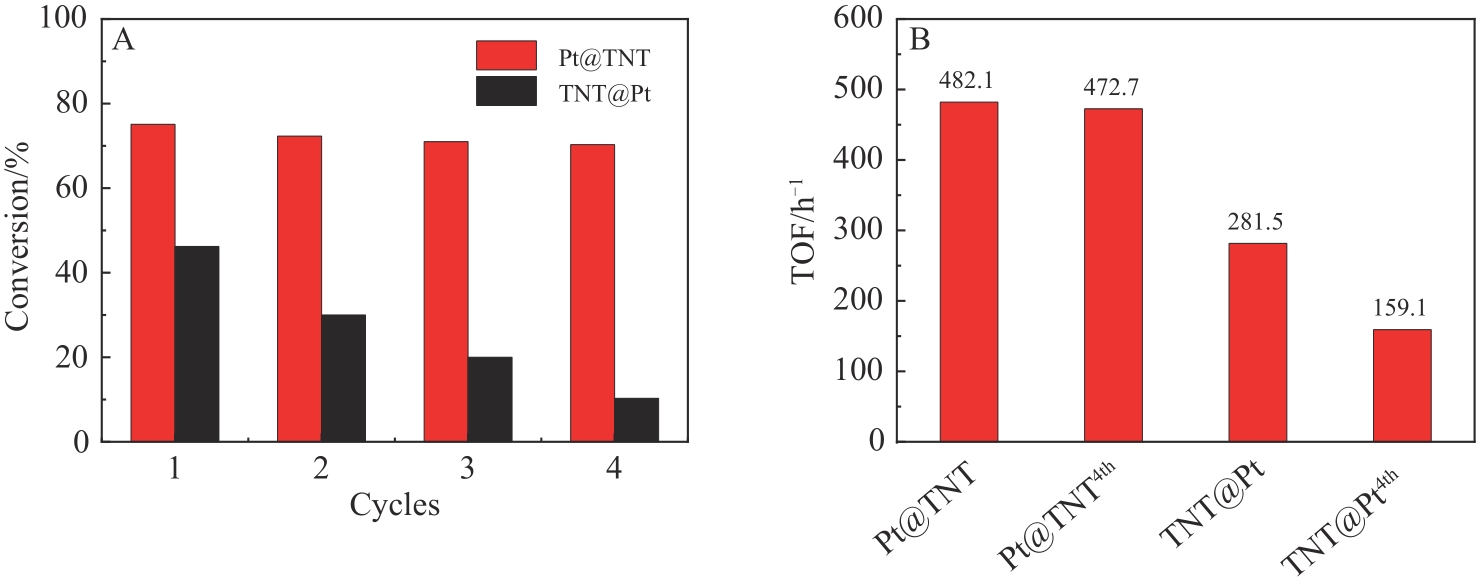
Fig.5 (A) The recycling stability of phenol hydrogenation for the catalysts (the reaction time is 1 h per run for both catalysts); (B) The comparison of TOF values of phenol hydrogenation
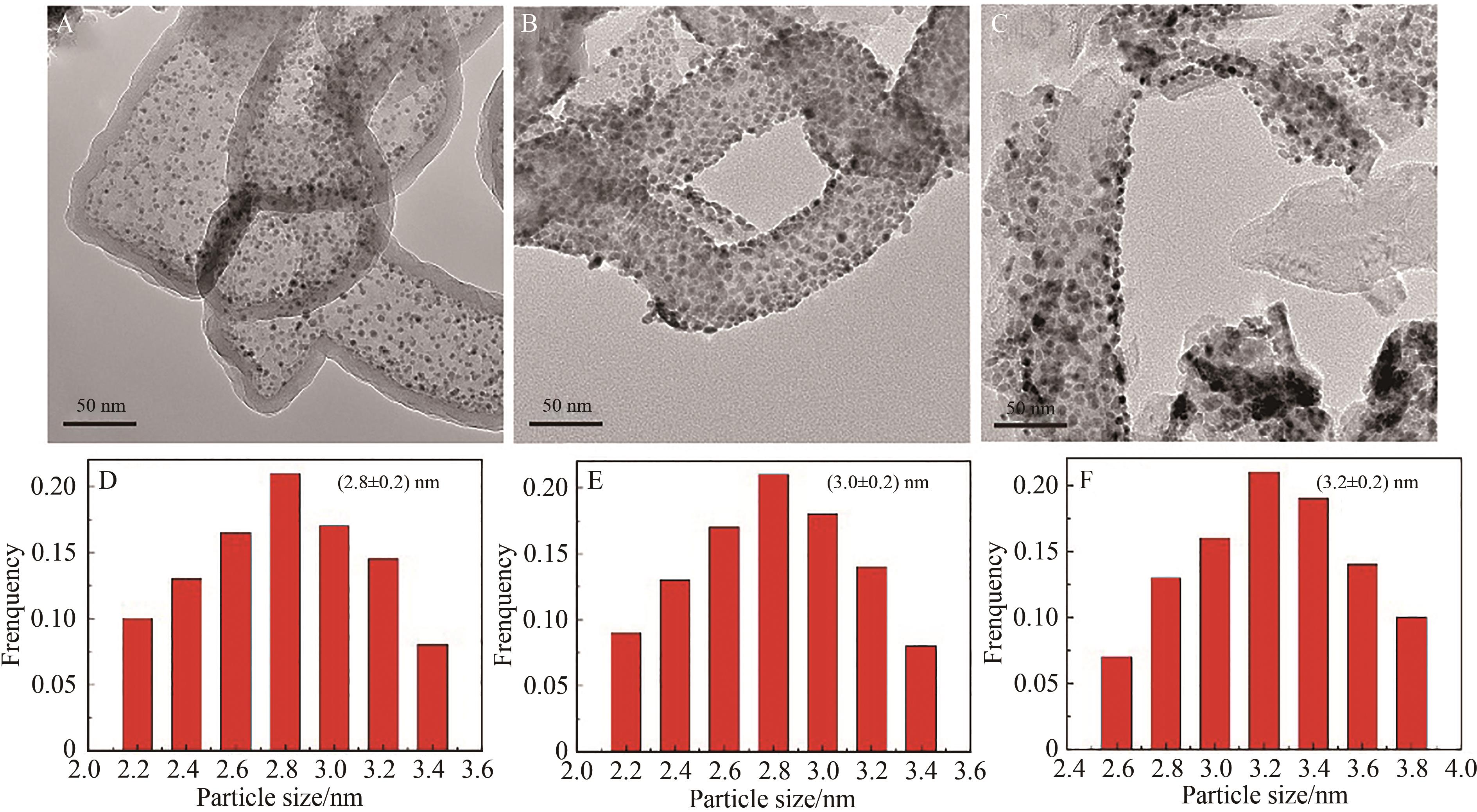
Fig.6 TEM images of (A) Pt@TNT after reaction, (B) TNT@Pt before, after reaction (C) and size distribution of corresponding Pt nanoparticles (D, E, F)
| 1 | LIU S, HAN J, WU Q. Hydrogenation of phenol to cyclohexanone over bifunctional Pd/C-heteropoly acid catalyst in the liquid phase[J]. Catal Lett, 2019, 149(9): 2383-2389. |
| 2 | PORWA G, GUPTA S, SREEDHALA S, et al. Mechanistic insights into the pathways of phenol hydrogenation on Pd nanostructures[J]. ACS Sustainable Chem Eng, 2019, 7(20): 17126-17136. |
| 3 | LI F, CAO B, ZHU W X, et al. Hydrogenation of phenol over Pt/CNTs: the effects of Pt loading and reaction solvents[J]. Catalysts, 2017, 7(5): 145. |
| 4 | 罗二桂, 唐涛, 王艺, 等. 两电子氧还原制备过氧化氢: 贵金属催化剂的几何与电子结构调控的研究进展[J]. 应用化学, 2023, 40(8): 1063-1076. |
| LUO E G, TANG T, WANG Y, et al. Progress on tuning the geometric and electronic structure of precious metal catalysts for hydrogen peroxide production via two-electron oxygen reduction[J]. Chin J Appl Chem, 2023, 40(8): 1063-1076. | |
| 5 | SONG Y, GUTIERREZ O Y, HERRANZ J, et al. Aqueous phase electrocatalysis and thermal catalysis for the hydrogenation of phenol at mild conditions[J]. Appl Catal B: Environ, 2016, 182: 236-246. |
| 6 | YANG X, YU X, LONG L Z, et al. Pt nanoparticles entrapped in titanate nanotubes (TNT) for phenol hydrogenation: the confinement effect of TNT[J]. Chem Commun, 2014, 50(21): 2794-2796. |
| 7 | ZHANG H C, XU B, WANG X. Engineering nanointerfaces for nanocatalysis[J]. Chem Soc Rev, 2014, 43(22): 7870-7886 |
| 8 | ZHANG F, JIAO F, PAN X L, et al. Tailoring the oxidation activity of Pt nanoclusters via encapsulation[J]. ACS Catal, 2015, 5(2): 1381-1385. |
| 9 | 朱诗尧, 李平, 叶黎城, 等. 基于Pt/CNTs催化剂的燃料电池Pt/Buckypaper催化层的制备与表征[J]. 材料工程,2018, 46(6): 27-35. |
| ZHU S Y, LI P, YE L C, et al. Preparation and characterization of Pt/Buckypaper catalytic layer based on Pt/CNTs catalyst for fuel cells[J]. J Mater Eng, 2018, 46 (6): 27-35. | |
| 10 | 杨春巍, 胡信国, 张亮, 等. 多壁碳纳米管的超声处理对PtRu/MWCNTs电催化性能的影响[J]. 材料工程, 2008(7): 79-82. |
| YANG C W, HU X G, ZHANG L, et al. Study of functionalization multiwall carbon nanotubes by ultrasound[J]. J Mater Eng, 2008(7): 79-82. | |
| 11 | NAKAMURA I, MANTOKU H, FURUKAWA T, et al. Active sites for hydrogen dissociation over TiOx/Au(111) surfaces[J]. J Phys Chem C, 2011, 115(32): 16074-16080. |
| 12 | ZHAO W X, WANG X T, SANG H X, et al. Synthesis of Bi-doped TiO2 nanotubes and enhanced photocatalytic activity for hydrogen evolution from glycerol solution[J]. Chin J Chem, 2013, 31(3): 415-420. |
| 13 | JIANG D W, ZHOU T S, SUN Q, et al. Enhanced visible-light-induced photoelectrocatalytic degradation of methyl orange by CdS sensitized TiO2 nanotube arrays electrode[J]. Chin J Chem, 2011, 29(11): 2505-2510. |
| 14 | DONG J N, HUANG J Y, WANG A, et al. Vertically-aligned Pt-decorated MoS2 nanosheets coated on TiO2 nanotube arrays enable high-efficiency solar-light energy utilization for photocatalysis and self-cleaning SERS devices[J]. Nano Energy, 2020, 71: 104-579. |
| 15 | MAITY S, RANA M, BEJ S, et al. TiO2-ZrO2 mixed oxide as a support for hydrotreating catalyst[J]. Catal Lett, 2001, 72: 115-119. |
| 16 | WU Z F, LI Y Y, HUANG W X. Size-dependent Pt-TiO2 strong metal-support interaction[J]. J Phys Chem Lett, 2020, 11(12): 4603-4607. |
| 17 | HAN B, GUO Y L, HUANG Y K, et al. Strong metal-support interactions between Pt single atoms and TiO2[J]. Angew Chem Int Ed, 2020, 59(29): 11824-11829. |
| 18 | LOU B H, CHEN C L, LIU J J, et al. Selectively depositing Bi2O3 quantum dots on TiO2 nanotubes for efficient visible-light-driven photocatalysis[J]. Mater Lett, 2021, 288: 129-413. |
| 19 | TSUCHIYA H, SCHMUKI P. Less known facts and findings about TiO2 nanotubes[J]. Nanoscale, 2020, 12(15): 8119-8132. |
| 20 | ZHAO Y X, ZHU L J, YU Y M, et al. Facile one-pot preparation of Ti3+, N co-doping TiO2 nanotube arrays and enhanced photodegradation activities by tuning tube lengths and diameters[J]. Catal Today, 2020, 355: 563-572. |
| 21 | 于亚洲, 赵先亮, 谭宁宁, 等. 聚烯丙胺改性磺酸催化剂催化苯甲酸正丁酯的合成[J]. 应用化学, 2023, 40(10): 1430-1436. |
| YU Y Z, ZHAO X L, TAN N N, et al. Polyallylamine modified sulfonic acid catalyst catalyse synthesis of n-butyl benzoate[J]. Chin J Appl Chem, 2023, 40(10): 1430-1436. | |
| 22 | WANG M H, GAO Z, ZHANG B, et al. Ultrathin coating of confined Pt nanocatalysts by atomic layer deposition for enhanced catalytic performance in hydrogenation reactions[J]. Chem Eur J, 2016, 22(25): 8438-8443. |
| 23 | ZHANG J K, YU Z B, GAO Z, et al. Porous TiO2 nanotubes with spatially separated platinum and CoOx cocatalysts produced by atomic layer deposition for photocatalytic hydrogen production[J]. Angew Chem Int Ed, 2017, 56(3): 816-820. |
| 24 | KIM M, BAE C, KIM H, et al. Confined crystallization of anatase TiO2 nanotubes and their implications on transport properties[J]. J Mater Chem A, 2013, 1(45): 14080-14088. |
| 25 | QIN Y, ZHANG Z K, CUI Z L. Helical carbon nanofibers with a symmetric growth mode[J]. Carbon, 2004, 42(10): 1917-1922. |
| 26 | WANG M H, LI Y, GAO X L, et al. TiO2 ultrathin coating of SBA-15/Au by atomic layer deposition for enhanced catalytic performance in epoxidation of styrene[J]. J Phys Chem C, 2020, 124(19): 10530-10540. |
| 27 | QIN Y, ZHANG Z K, CUI Z L. Helical carbon nanofibers prepared by pyrolysis of acetylene with a catalyst derived from the decomposition of copper tartrate[J]. Carbon, 2003, 41(15): 3072-3074. |
| 28 | YAO Q, WANG C, WANG H, et al. Revisiting the Au particle size effect on TiO2-coated Au/TiO2 catalysts in CO oxidation reaction[J]. J Phys Chem C, 2016, 120(17): 9174-9183. |
| 29 | SU X, LU K L, CHANG Y L, et al. Immersion deposition of Pt nanoparticles on porous silicon for methanol oxidation[J]. Chin J Chem, 2009, 27(9):1682-1686. |
| 30 | GAO Z, DONG M, WANG G Z, et al. Multiply confined nickel nanocatalysts produced by atomic layer deposition for hydrogenation reactions[J]. Angew Chem Int Ed, 2015, 54: 9006-9100. |
| 31 | WANG C J, LIU X, HE W J, et al. All-solid-state Z-scheme photocatalysts of g-C3N4/Pt/macroporous-(TiO2@carbon) for selective boosting visible-light-driven conversion of CO2 to CH4[J]. J Catal, 2020, 389: 440-449. |
| 32 | XIE J, YU Z H, XIA D G. Electrochemical sensor for oxidation of NO based on Au-Pt nanoparticles self-assembly film[J]. Chin J Chem, 2009, 27(5):887-890. |
| [1] | ZHU Yiming, ZHANG Hao, ZHANG Jun, MI Gang, SONG Bangcai, DU Xigang. Preparation and Catalytic Performance Evaluation of Multi-metal Catalysts for Conversion of Tetrachloromethaneto Trichloromethane by Liquid Phase Hydrogenation [J]. Chinese Journal of Applied Chemistry, 2017, 34(2): 242-244. |
| [2] | JIA Yujie, TANG Yawen, CHEN Yu, ZHOU Yiming, LU Tianhong*. Effect of Atomic Ratio of Pd and Pt in Carbon supported Pd-Pt Catalyst on its Cathodic Performance in Direct Methanol Fuel Cell [J]. Chinese Journal of Applied Chemistry, 2011, 28(02): 224-228. |
| [3] | WANG Yan-En1, CAO Shuang2, TANG Ya-Wen3, WANG Chun1, MA Jing-Jun1, LU Tian-Hong3*. Electrocatalytic Performance of Carbon-Supported Pt-P Catalyst for Oxygen Reduction [J]. Chinese Journal of Applied Chemistry, 2011, 28(01): 44-47. |
| [4] | YANG Gai-Xiu1, DENG Ling-Juan2, TANG Ya-Wen1, LIU Tian-Hong1*. Promote Action of Phosphotungstic acid on Electrooxidation of Fomic Acid at Carbon Supported Pt Catalyst [J]. Chinese Journal of Applied Chemistry, 2009, 26(12): 1476-1479. |
| Viewed | ||||||
|
Full text |
|
|||||
|
Abstract |
|
|||||
